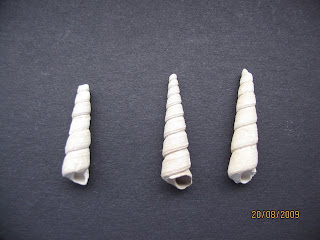Could describe the areas current population, being as it's full of elderly and very elderly retirees! Not only that but Crumbling Cliff is now one of them! However, speaking literally rather than metaphorically, and geologically to boot, a little bit of crumble didn't harm anyone. This process reveals a wealth of ancient animal life along a relatively short stretch of the south coast. The soft "rocks" around here, across to the Isle of Wight and back to Selsey range from approximately 54.0 to 23.0 million years in age and represent some of the best examples of Eocene and Oligocene deposits in Britain. Fossils abound in the Barton Beds which contain good specimens of bivalves and gatropods (see below example of Turritella sp. from the Upper Eocene 40.0-36.0 million years ago). A short, if expensive, ferry ride across to Hamstead Bay on the Isle of Wight brings you forward a few million years (rather than back a million years or so - as some may say after having been to the Isle of Wight in February!) to the Oligocene and along the beach are revealed small pieces of turtle shell.
A short, if expensive, ferry ride across to Hamstead Bay on the Isle of Wight brings you forward a few million years (rather than back a million years or so - as some may say after having been to the Isle of Wight in February!) to the Oligocene and along the beach are revealed small pieces of turtle shell. Taking a trip further along the coast to the east, the western side of the Selsey peninsula at Bracklesham is excellent for finding shark's teeth. These deposits are quite a bit older at 50.0-40.0 million years.
Taking a trip further along the coast to the east, the western side of the Selsey peninsula at Bracklesham is excellent for finding shark's teeth. These deposits are quite a bit older at 50.0-40.0 million years. Careful where you tread!
Careful where you tread!
 A short, if expensive, ferry ride across to Hamstead Bay on the Isle of Wight brings you forward a few million years (rather than back a million years or so - as some may say after having been to the Isle of Wight in February!) to the Oligocene and along the beach are revealed small pieces of turtle shell.
A short, if expensive, ferry ride across to Hamstead Bay on the Isle of Wight brings you forward a few million years (rather than back a million years or so - as some may say after having been to the Isle of Wight in February!) to the Oligocene and along the beach are revealed small pieces of turtle shell.

Hi CC. Interesting stuff. Good to see your blog up and running. If you haven't found it yet you might be interested in http://wightrambler.blogspot.com/
ReplyDeleteKeep the posts coming!